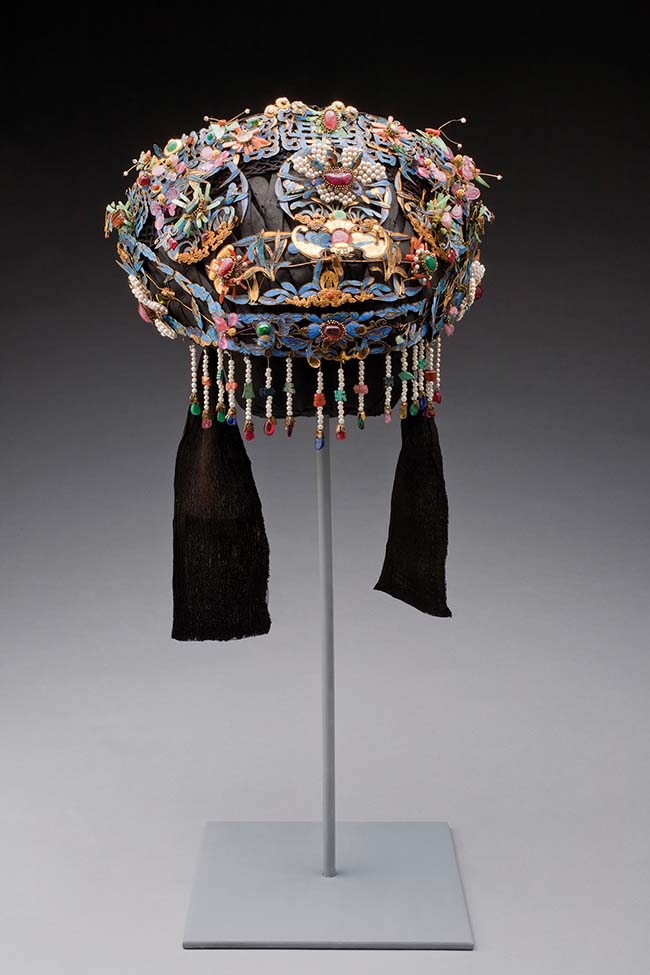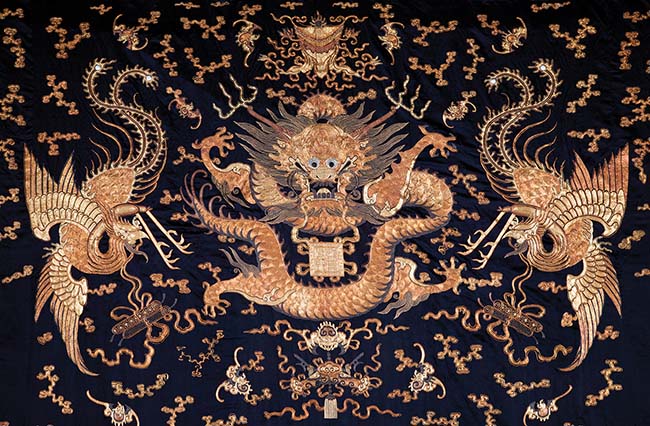by Jane Durrell
It was Mark Twain who told us “Clothes make the man,” adding a Twain-ish thought about the little influence naked men have on society. Certainly the Manchu, who came roiling in from the northeast to take over the whole of China in the 17th century, bought the sentiment, for both men and women. In this final Chinese dynasty, the Qing, in place until 1911, women were the equals of men and held the reins of power as firmly as the males, dressing for their roles with comparable relish.
Threads of Heaven: Silken Legacy of China’s Last Dynasty at the Taft Museum now through May 18, is off to a socko start with “Wedding Headdress” as the first object to meet the visitor’s eye. Weddings have always been an irresistible excuse for showing off (see Princess Diana’s wedding dress, now at the Cincinnati Museum Center) and this headdress- made of kingfisher feathers, metal, glass, ceramics and silk – is a gorgeous medley of blues picked out by gold and pink.
Moving into the main gallery, the use of clothing to announce one’s place in society is quickly established by a banner displaying badges that state who the wearer must be. That is, the imperial family could wear dragon-depicting badges, civilian badges displayed birds, military had representations of animals and so forth. The badges, large and lustrous, are executed with the skill that comes of taking ultimate time and care and using the most elegant of materials.
The robes are trimmer than those of the immediate past, the label tells us, reflecting the Manchu as inveterate horsemen and archers, but with no loss of luxury. They are silk, one is lined with leopard fur against winter cold, yellow denotes a royal wearer. The Chinese climate must have something in common with the American midwest: extremes of hot and cold. The leopard skin lining is balanced out by an under-jacket fashioned from cotton and slim stalks of bamboo, to allow air circulation in the heat of summer.
Because historic regimes, unlike the Manchu, often held women in secondary status, the women’s robes in the next section of the exhibition are of particular interest. Sleeve endings are wider than those of the men and the decorations are perhaps more feminine, but the level of skill and luxury of material is fully equal. One robe in particular, of distinctive cut and decoration, is understood to have been designed by a dowager empress who felt royal yellow not compatible to her complexion. The yellow certainly appears, but not at the neckline, and all of us who think about what we wear feel a surge of understanding.
A glowing red robe, informal outer clothing for some fortunate woman, is thought to have been inspired by the red of the English Red-Coat military, a fortuitous inspiration in a land where red signifies happiness. The English surely had something other than happiness in mind. Another, perhaps the prettiest of these robes for women, would have been in the wardrobe of an ethnic Chinese, not a Manchu. It is shorter than the Manchu robes, has wide sleeves and would have been worn over a paneled skirt. It is a beguiling shade of turquoise. The embroidery on all these fetching garments is exquisite.
Accessories are not forgotten. There are summer hats, winter hats, hats that speak of the importance of the wearer. There are fingernail protectors, for those who grow their fingernails in visible repudiation of working with their hands. And perhaps most interesting, in a society that hasn’t yet invented the shirt pocket, the pants pocket or any clothing-based pocket at all, there are innumerable means of carrying small things in interestingly shaped containers that sometimes can be fastened to a belt. Among things being carried: fans, eye glasses.
The exhibition winds up in the rear section of the entrance to the Taft’s special exhibitions gallery with a painting of a Chinese opera in which extravagant costuming helps to carry the story line. One wonders how they could perform at all, in the weight of the costumes, but opera was and continues to be a popular part of the culture. A small case displays examples of a custom now wholly defunct: shoes for bound feet. They are incredibly tiny, as the foot would be only four inches long, and are fashioned from beautifully colored and adorned silk. They make one’s toes curl in distress. Manchu women, of course, never subscribed to this practice and in fact it did not survive into the 20th century. What Manchu women did wear were platform shoes, also seen here, which were thought to give them the titillating gait of the hobbled Chinese women.
The exhibition is drawn from the permanent collection of the Denver Museum of Art, and is almost completely a reflection of works gathered by a private collector, like the Tafts, who focused on Chinese imperial garments and textiles in the 1920s and ’30s. The Tafts’ own Chinese objects, an important element of their acquisitions, are almost completely from the same era as those in this exhibition, making Threads of Heaven a natural fit into the schedule here. Pointing up this relationship, a few pieces from the Taft collection are part of the exhibition. In one case, near the royal robes sporting five-clawed dragons is a Taft ceramic with its own five-clawed dragon. There is an implicit invitation to visit the permanent collection before you leave, to make your own connections between the Museum’s ceramics and the fabrics in the show.
The Taft Museum of Art, 316 Pike Street downtown, is open 11 a.m. – 4 p.m. Wednesday-Friday; 11 a.m. – 5 p.m. Saturday-Sunday. Admission charge every day but Sunday; members free.








